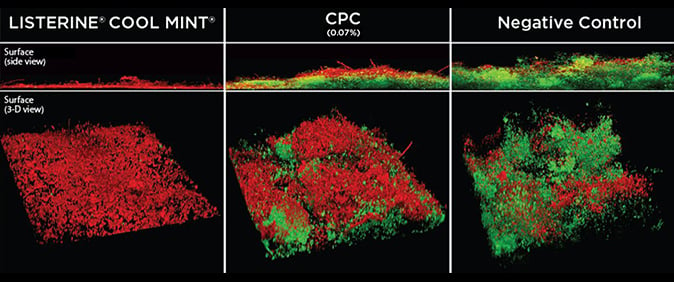
A HEALTHY MOUTH IS FUNDAMENTAL TO A HEALTHY PATIENT
Did you know over 90% of bacteria survive as protected communities in biofilms?1 That's why it's important to keep biofilm thin and oral bacteria in check. With a good oral hygiene routine, biofilm remains thin and the mouth is a healthy environment—the pH balance is safe, bacterial load is low, and the complexity of the bacterial population in the oral cavity is controlled.2
However, when oral hygiene falters, plaque is able to mature, colonize, and grow. This creates a thicker biofilm containing more complex, virulent bacteria.2,3

LISTERINE® Antiseptic works differently to keep biofilm thin
The unique formulation of essential oils disrupts the bacterial cell wall to kill plaque and gingivitis organisms in virtually 100% of the mouth. This mechanism of action ensures a deep clean when using a mouth rinse with essential oils. Essential oils exhibit a broad spectrum of activity against gram-positive and gram-negative bacteria and against fungi. As a result, biofilm growth and vitality are reduced, regeneration time of bacteria is increased, and bacterial endotoxin levels are reduced, all of which in turn decrease the pathogenicity of biofilm.4-8
LISTERINE® Antiseptic penetrates plaque biofilm deeper than cetylpyridinium chloride (CPC)2
Rinses containing CPC only go so far, and in lab studies they have been proven to kill less bacteria.
Recommend a rinse with deeper plaque biofilm penetration: (confocal microscopy of living biofilm cells [green] and dead biofilm cells [red] at deepest layer)2*
Kills 1.8x More Bacteria Than CPC

For information and resources to share with your patients on the impact of biofilm, click here.
*Lab study: Mixed species biofilm growth 48 hours prior to 30-second treatment with mouth rinse or sterile water.2
References:
1. Ilyina TS, Romanova YM, Gintsburg AL. Biofilms as a mode of existence of bacteria in external environment and host body: the phenomenon, genetic control, and regulation systems of development. Russ J Genet. 2004;40(11):1189-1198.
2. Data on file, Johnson & Johnson Consumer Inc.
3. Lamont RJ, Hajishengallis G. Polymicrobial synergy and dysbiosis in inflammatory disease. Trends Mol Med. 2015;21(3):172-183.
4. Charles CH, Sharma NC, Galustians HJ, Qaqish J, McGuire JA, Vincent JW. Comparative efficacy of an antiseptic mouthrinse and an antiplaque/antigingivitis dentifrice: a six-month clinical trial. J Am Dent Assoc. 2001;132(5):670-675. 5. Fine DH, Letizia J, Mandel ID. The effect of rinsing with Listerine antiseptic on the properties of developing dental plaque. J Clin Periodontol. 1985;12(8):660-666.
6. Kubert D, Rubin M, Barnett ML, et al. Antiseptic mouthrinse-induced microbial cell surface alterations. Am J Dent. 1993;6(6):277-279.
7. Pan P, Barnett ML, Coelho J, Brogdon C, Finnegan MB. Determination of the in situ bacteria
